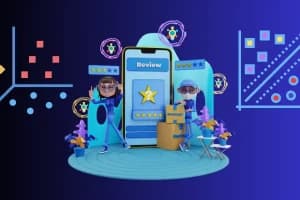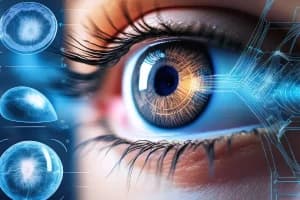Data science is still advanced and Python remains the language of choice for solving big data scenarios. Starting with data manipulation and going all the way up to construction of the state-of-art machine learning models, Python possesses various libraries that help improve efficiency and invention. Finally, we present 20 great Python libraries for data scientists of 2025 and corresponding project ideas for your reference.
1. Pandas
Pandas is a crucial library for data manipulation and analysis. It enables you to efficiently handle and transform structured data through its DataFrame and Series structures. Whether you're cleaning data, merging datasets, or conducting exploratory data analysis (EDA), Pandas is an essential tool for any data science project. Its user-friendly interface and robust features make it the foundation of most data manipulation tasks.
Key Features:
- Intuitive DataFrame and Series structures for handling and analyzing structured data.
- Robust tools for data manipulation, including merging, reshaping, and aggregation.
- Support for time-series functionality and operations.
- Advanced group-by-operations and time-series analysis tools.
- Built-in support for handling missing data and outliers.
Use Case:
- Project: Build Regression Models in Python for House Price Prediction
Utilize Pandas to preprocess real estate data by cleaning, transforming, and merging various datasets to create a regression model to predict house prices. This project highlights how Pandas can simplify data manipulation tasks and effectively prepare data for machine learning models. View Project
2. NumPy
NumPy powers numerical and scientific computing, enabling efficient array operations and seamless integration with TensorFlow, Scikit-learn, and PyTorch. It is the core library for numerical computing in Python. It provides support for multi-dimensional arrays and matrices, which are the foundation for most machine learning and scientific computing tasks. It integrates well with other libraries like TensorFlow, Scikit-learn, and PyTorch, making it an indispensable tool for data scientists.
Key Features:
- Multi-dimensional array objects for efficient numerical computations.
- Tools for performing advanced mathematical operations on arrays.
- Seamless integration with machine learning libraries like TensorFlow, Scikit-learn, and PyTorch.
- Random sampling, linear algebra, and Fourier transform capabilities
Use Case:
- Project: Building Regression Models Using NumPy
In this project, NumPy is used to build regression models like linear and ridge regression from scratch. By understanding the math behind these models, you can implement them manually and optimize performance without relying on high-level APIs. View Project
3. Scikit-learn
Scikit-learn is one of the most popular libraries for machine learning in Python. It offers a wide range of supervised and unsupervised algorithms, model evaluation tools, and feature engineering utilities. Scikit-learn simplifies the machine learning pipeline, making it easy to experiment with different algorithms, fine-tune models, and evaluate performance.
Key Features:
- Wide range of supervised and unsupervised algorithms.
- Feature engineering and selection tools.
- Model evaluation metrics and cross-validation techniques.
Use Case:
- Project: Credit Card Default Prediction Using Machine Learning Techniques
Use Scikit-learn to train classification models that predict credit card defaults based on customer data. This project helps you understand how to apply machine learning models to real-world problems and evaluate their performance. View Project
4. TensorFlow
TensorFlow is a powerful library for building and deploying machine learning models, particularly for deep learning tasks. It allows you to create complex neural networks, including convolutional neural networks (CNNs) and recurrent neural networks (RNNs). TensorFlow also supports distributed computing and deployment to mobile and cloud environments, making it highly scalable.
Key Features:
- Flexible APIs for creating deep learning models.
- Pre-trained models for transfer learning and faster prototyping.
- Scalable deployment options for mobile, web, and cloud environments.
- Support for advanced deep learning techniques like reinforcement learning and generative models.
Use Case:
- Project: Skin Cancer Detection Using Deep Learning
Use TensorFlow to build a convolutional neural network (CNN) for classifying skin lesions and detecting signs of skin cancer. TensorFlow's flexible API allows you to build complex models for image classification and improve model accuracy with transfer learning. View Project
5. PyTorch
PyTorch is an open-source machine learning library that is especially popular in research because of its dynamic computation graph. It offers flexibility and user-friendliness for deep learning tasks, making it perfect for experimentation. Additionally, PyTorch has robust support for computer vision and natural language processing (NLP) tasks, and it integrates smoothly with other machine learning libraries.
Key Features:
- A dynamic computation graph that simplifies the process of modifying models.
- Robust support for tasks in computer vision and natural language processing.
- Seamless integration with TensorBoard for visualizing models.
- A comprehensive library that supports the training of deep learning models, including convolutional neural networks (CNNs) and recurrent neural networks (RNNs).
Use Case:
- Project: Vegetable classification with Parallel CNN model
Create and build a parallel version of a CNN model with PyTorch to sort vegetables from pictures in a database. PyTorch lets you quickly try diverse neural network setups because it works well and is easy to operate. View Project
6. Plotly
Plotly is a data visualization library that enables you to create interactive, high-quality charts and dashboards. It's especially effective for intuitively and engagingly. Plotly offers a diverse array of visualizations, including 3D and geospatial charts, making it ideal for data storytelling.
Key Features:
- Support for interactive visualizations and dashboards.
- Real-time data streaming features for live visualizations.
- Enhanced support for 3D and geospatial plotting.
- Option to export interactive charts to web applications.
Use Case:
- Project: Build A Book Recommender System With TF-IDF And Clustering(Python)
Use Plotly to visualize clustering results in a book recommender system, enhancing interpretability for stakeholders. Plotly's interactive charts allow users to better explore and understand how recommendations are made. View Project
7. Statsmodels
Statsmodels is a powerful Python library for statistical modeling and time-series analysis. It provides tools for regression, hypothesis testing, and advanced time-series techniques like ARIMA and SARIMAX, making it an essential library for working with time-dependent data.
Key Features:
- Tools for time-series models such as ARIMA, SARIMAX, and more.
- Statistical tests, including hypothesis testing, ANOVA, and t-tests.
- Regression analysis with detailed statistical diagnostics.
- Integration with Pandas for easy data handling.
Use Case:
- Project: Time Series Forecasting with ARIMA and SARIMAX Models in Python
Use Statsmodels to process large time-series datasets and build accurate forecasting models. View Project
8. Hugging Face Transformers
Hugging Face Transformers has transformed the natural language processing (NLP) landscape by offering a diverse range of pre-trained models. It provides readymade language models that help users tackle key tasks across multiple language domains. The library has a simple way to work with it and follows already-trained models, which helps developers build NLP options quickly without starting everything from scratch. Just like that, Hugging Face has made it possible to adapt models to work with your specific data through their fine-tuning tools.
Key Features:
- Their models are prepared for different NLP needs like creating text, reading feelings, converting languages, and more.
- Simple tools to let you adjust ready-made models to work best with your specific project needs.
- Hugging Face helps AI work better by giving it tools to handle three types of input information: words, images, and sound.
- Simple API lets developers easily connect transformer technology to their projects through short, basic coding commands.
- Small models are made to set up rapidly on basic gadgets like smartphones or smartwatches.
Use Case:
- Project: Question Answer System Training With Distilbert Base Uncased
Fine-tune a transformer model like DistilBERT to build a chatbot that answers healthcare-related questions. This project demonstrates how fine-tuning domain-specific data improves model performance. View Project
9. Matplotlib
Matplotlib gives Python users multiple ways to make both animated and interactive charts. People use Matplotlib to make graph plots because it works smoothly with both Pandas and NumPy. Matplotlib lets you fully adjust and improve any chart or figure you make to look correct in a published piece.
Key Features:
- This tool comes with many different chart options: bar, line, scatter, histogram, and more.
- Easy connection to Jupyter Notebook lets you examine data graphs directly.
- Complete flexibility to improve the way visuals look.
- Users can move around and look at graphics by zooming and sliding their way through them.
Use Case:
- Project: NLP Project for Beginners on Text Processing and Classification
Use Matplotlib to visualize the distributions of text data and the classification results of a text classification model. This helps in understanding the patterns in the data and evaluating model performance. View Project
10. Streamlit
Streamlit helps developers make web applications that users can easily interact with, and it's free for everyone to use. Streamlit lets you create all your web applications, dashboards, data graphs, and machine-learning features with less manual work. Streamlit works best when turning your Python projects into tools you can show and share with your customers.
Key Features:
- Tools for building web apps with Python scripts.
- Interactive widgets for user input and real-time data exploration.
- Easy deployment to cloud platforms, including serverless platforms.
- Instant feedback while editing code, making it great for rapid prototyping.
Use Case:
- Project: Word2Vec and FastText Word Embedding with Gensim in Python
This project deals with applying various techniques from Natural Language Processing to the analysis and interactive visualization of data using Streamlit. View Project
11. SciPy
SciPy extends NumPy by helping scientists solve optimization, integration, interpolation, and statistical issues. The library provides the best results when you need to solve mathematical problems that demand complex algorithms or advanced math.
Key Features:
- Tools for finding optimal solutions in numerical problems and computational integration.
- Advanced statistical methods and theory calculations.
- The tool combines digital signal processing with matrix operations and fast Fourier transforms.
- Built on top of NumPy for easy integration.
Use Case:
- Project: Build an Autoregressive and Moving Average Time Series Model
Use SciPy to optimize parameters and analyze AR and MA models for time series forecasting. View Project
12. NLTK
NLTK provides all necessary tools for natural language processing including functions to process text through tokenization parsing stemming and tagging. The product provides both extensive text databases plus linguistic resources.
Key Features:
- Built-in support for tokenization, stemming, and POS tagging.
- Built-in functions help users process text in small parts while understanding word meaning and structure.
- An NLP model gains access to data sets of different sizes for all its language processing tasks.
- Our system integrates directly with machine learning services to perform classification and cluster analysis.
Use Case:
- Project: Build Multi-class Text Classification Models with RNN and LSTM
Use NLTK to preprocess and analyze text data before feeding it into a Recurrent Neural Network (RNN) or Long Short-Term Memory (LSTM) network for multi-class classification. View Project
13. Pylab
Pylab combines NumPy, SciPy, and Matplotlib into a single package to deliver complete numerical computation and graphical display capabilities. The tool is the best for fast prototyping and mathematical work plus data visualization at any moment.
Key Features:
- Both 2D and 3D plotting features are supported.
- The tool provides basic commands that help developers work fast while discovering new ideas.
- Integration of NumPy, SciPy, and Matplotlib for a unified workflow.
Use Case:
- Project: Time Series Forecasting with ARIMA and SARIMAX Models in Python
Use Pylab to visualize time-series data while performing ARIMA or SARIMAX model analysis, making it easier to track predictions and model outputs. View Project
14. Wordcloud
Wordcloud is a library that generates visually appealing word clouds from text data, allowing you to highlight word frequency in an engaging format. It's particularly useful for understanding textual data, visualizing the most frequent terms in datasets, and conveying insights in an easily digestible way.
Key Features:
- Fast API lets users make word clouds from their text data
- The tool works well with different text data types to help you use it with your analysis process.
- Wordcloudlets users modify Word Cloud design and choose color settings.
Use Case:
- Project: Sentiment Analysis for Mental Health Using NLP & ML
Use Wordcloud to visualize the key themes in datasets related to mental health. This approach aids in grasping the prevalent topics and emotional tones within the data, offering deeper insights into the issues being addressed. View Project
15. SHAP
Shap values are used to explain the results of any machine learning model. It employs a game theory approach that assesses each player's contribution to the final result. In machine learning, each feature is assigned a significance value indicating its contribution to the model's output.
Key Features:
- Local and global interpretability of model predictions.
- Visualization tools to explain feature importance and contributions.
- Supports both tabular data and image data, making it versatile.
- Can be applied to any machine learning model, providing model-agnostic explanations.
Use Case:
- Project: Credit Card Default Prediction Using Machine Learning Techniques
Use SHAP/LIME to analyze feature importance and understand model predictions. View Project
16. LIGHTGBM
LightGBM (Light Gradient Boosting Machine) is a leading gradient-boosting framework that runs machine learning processes quickly and saves memory for big datasets with category-based features. The model is built to work quickly while handling big data sets that contain labels and does well at both saving time and managing needed storage space.
Key Features:
- Faster training speed and higher efficiency.
- Lower memory usage.
- Better accuracy.
- Support of parallel, distributed, and GPU learning.
- Capable of handling large-scale data.
Use Case:
- Project: Learn to Build a Polynomial Regression Model from Scratch
Use LightGBM for efficient regression on complex datasets that involve non-linear relationships. Its ability to handle large-scale data and categorical features makes it a great choice for this type of project. View Project
17. Roboflow
Roboflow is a tool designed for simplifying image dataset preparation and augmentation for computer vision tasks. It helps automate the process of annotating and the augmentation of images. This can save significant time in building datasets for deep learning models.
Key Features:
- Automated image dataset annotation and augmentation.
- Compatibility with various deep learning frameworks like TensorFlow, PyTorch, and Keras.
- Tools for converting datasets into popular formats like YOLO, COCO, and Pascal VOC.
- Support for synthetic data generation to enhance model training.
Use Case:
- Project: Automatic Eye Cataract Detection Using YOLOv8
Roboflow helps in preparing and augmenting image datasets for cataract detection using the YOLOv8 object detection model. This allows you to build high-performance computer vision systems with fewer resources. View Project
18. XGBoost
As a gradient boosting tool, XGBoost handles heavy data swiftly and does advanced machine learning work well. It does classification and regression well, works quickly, and handles big datasets very easily, which is why people choose it for many different projects.
Key Features:
- Advanced regularization techniques to reduce overfitting.
- Support for distributed computing, enabling training on large-scale datasets.
- Efficient handling of sparse and imbalanced datasets.
- Parallelized processing for faster computation.
Use Case:
- Project: Topic modeling using K-means clustering to group customer reviews
Use XGBoost to enhance clustering models for customer reviews. By integrating XGBoost, you can improve prediction accuracy and handle large datasets efficiently. View Project
19. Ultralytics
Ultralytics is a library specifically created for working with YOLO (You Only Look Once) models, enabling real-time object detection and classification. It offers pre-trained models, fine-tuning tools, and seamless integration with computer vision workflows, making it perfect for real-time applications such as human pose detection and surveillance systems.
Key Features:
- Pre-trained YOLOv8 models for object detection.
- Tools for fine-tuning models on custom datasets.
- Optimized for edge AI and IoT integration.
- Support for multi-object tracking.
Use Case:
Project: Real-Time Human Pose Detection with YOLOv8
Use YOLOv8 models from Ultralytics to build a real-time human pose detection system. This can be applied in applications like fitness tracking or surveillance. View Project
20. LightFM
LightFM is a hybrid recommendation system library that combines collaborative filtering with content-based filtering to deliver personalized recommendations. It's optimized for sparse, large-scale datasets and is great for applications like e-commerce or media recommendation systems.
Key Features:
- Hybrid recommender system that combines collaborative and content-based filtering.
- Optimized for large, sparse datasets.
- Support for implicit and explicit feedback.
- Tools for integrating user and item metadata.
Use Case:
Project: Build a Hybrid Recommender System in Python Using LightFM
Create a recommendation system that uses user behavior and product features to suggest personalized items. This project shows how to integrate user and item metadata into a hybrid recommender system. View Project
FAQ
- How is Hugging Face Transformers useful for NLP tasks?
Hugging Face Transformers makes NLP tasks, including text generation, sentiment analysis, as well as translation, more accessible. Deepgram is a real-time recognition API that comes with pre-trained models that can be branded and easily retrained for niche uses such as chatbots.
- Can I create web applications using Python libraries?
Yes, Streamlit is a Python library intended to build web applications by running Python scripts. It is suitable for developing data visualization and for presenting machine learning models to relevant stakeholders.
- Are there any projects available to practice Python libraries for data science?
Yes, the AI Online Course offers a variety of hands-on projects like skin cancer detection, stock price forecasting, and chatbot development, all of which utilize essential Python libraries.
- What is the difference between TensorFlow and PyTorch?
TensorFlow offers the best solutions for production and deployment solutions while PyTorch is best suited for research and prototyping because of the feature of Dynamic computation graph.
Conclusion
Data science is still thriving in the Python ecosystem, firming its position as the leading tool in the field. By mastering these 10 libraries, you would be at an excellent start to solving all sorts of problems in analytics, machine learning, and visualization. It ranges from big data processing to AI model deployment to building dynamic dashboards, you can bet on these tools.
If you want to advance your knowledge even further, consider discovering the variety of AI projects related to such libraries below. It implies that there is no better way to be prepared for the future than through practical experience thus making the most of the continually changing area of data science.







